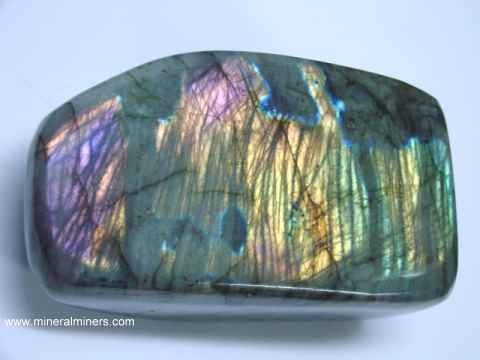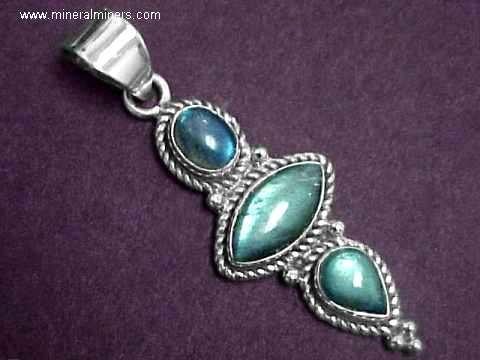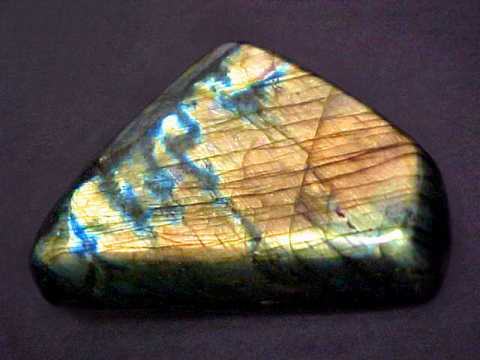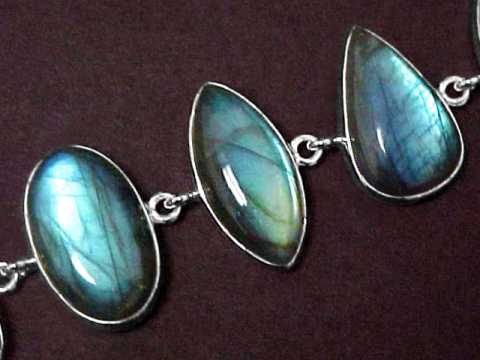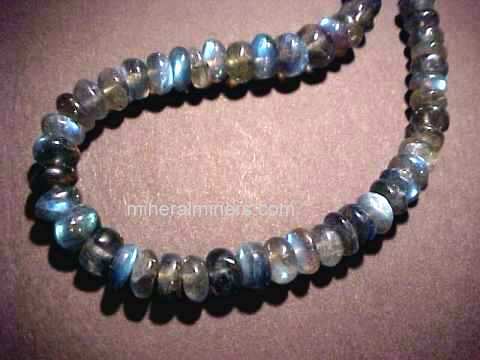


Enter our Virtual Gallery of
MINERALMINERS.COM®- Your Personal 'Link' Direct to the Labradorite Mines!TM
Labradorite Feldspar Information
Labradorite Feldspar is an iridescent variety of plagioclase feldspar.
See also our other natural feldspar gem varieties moonstone, sunstone and amazonite.
Links To Labradorite Information Topics On This Page:
Labradorite Products In Our Virtual Gallery:
(Take any link to enter our Online Store)
Return to the Index of
LABRADORITE PHYSICAL PROPERTIES
- Labradorite Chemical composition: the composition of the intermediate members of the plagioclase solid solution series are expressed in terms of the two pure end members of this series, albite (NaAlSi3O8) and anorthite (CaAl2Si2O8). Using this methodology, the composition of labradorite is thus expressed as Ab50-30%An50-70%.
- Class: tektosilicate
- Labradorite Crystal system: triclinic;
bar 1 - Labradorite Habit: usually as cleavable masses, also as irregular to euhedral grains, more rarely as tabular to prismatic crystals
- Twinning: polysynthetic lamellar twinning according to the albite twin law {010}, sometimes visible to the unaided eye as striations on {010}.
- Labradorite Specific gravity: 2.5-2.9
- Index of refraction: 1.560-1.572
- Birefringence: weak maximum birefringence of 0.010
- Pleochroism: generally colorless in section, darker color specimens can have distinct pleochrism
- Labradorite Hardness: 6-6.5
- Labradorite Color: usually gray to black, also colorless, white, yellow, orange to red, blue to green
- Luster: vitreous to pearly
- Labradorite Transparency: opaque to translucent, rarely transparent
- Labradorite Cleavage: characteristic cleavages are {001} perfect, {010} distinct
- Fracture: conchoidal to uneven
- Labradorite Streak: white
Return to the Index of
FELDSPAR BACKGROUND INFORMATION
In the earth's crust, feldspars are more abundant than all other minerals combined. The majority of the common feldspars fall into two groups, the alkali feldspars (KAlSi3O8 through NaAlSi3O8 series), and the plagioclase feldspars (NaAlSi3O8 through CaAl2Si2O8 series). Albite is an end member in each of these series. Labradorite is a member of the plagioclase series with chemical composition range just past the midpoint between albite (NaAlSi3O8) and anorthite (CaAl2Si2O8), expressed as Ab50-30%An50-70%.
At high temperatures, the alkali feldspars form a continuous solid solution series, however at medium to low crystalization temperatures the sodium feldspar (albite) and potassium feldspar (microcline or orthoclase) separate forming lattice type exsolution intergrowths, usually as thin layers of albite roughly parallel to {100} in a host crystal of microcline or orthoclase. This is known as perthitic texture. In Adularia, an unusually pure variety of the potassium feldspar orthoclase, an iridescent luster known as moonstone is sometimes present. This iridescence is due to diffused light reflection from microscopic parallel intergrowths of albite and orthoclase.
The plagioclase feldspars form in a basically continuous solid solution series from pure sodium to pure calcium end members as follows: albite - oligoclase - andesine - labradorite - bytownite - anorthite. The calcium rich plagioclase feldspars are the first to begin crystalizing from molten rock at higher temperatures, thereby concentrating sodium in the melt as the temperature decreases. Thus, in low temperature final crystalization phases (such as granitic pegmatites), the last plagioclase feldspar to crystalize would be the sodium end member albite.
Return to the Index of
LABRADORITE OCCURRENCE AND DIAGNOSTIC FEATURES
Labradorite is characteristic of gabbros and basalts. It is the main constituent of the plutonic rock anorthosite.
Some gray to black labradorite shows an iridescent play of blue, green, orange, yellow or red colors. These colors are due to light interference by thin lamellae (parallel layers) within the labradorite. Labradorite of this quality is very popular as a gem, lapidary and ornamental material.
Labradorite can be distinguished from other plagioclase feldspars by its specific gravity and refractive index. Plagioclase feldspars can be distinguished from most other common feldspars by the presence of albite twin striations. Iridescent labradorite is recognizable by its play of colors.
Return to the Index of
LABRADORITE HISTORICAL INFORMATION AND USES
The name labradorite comes from the province of Labrador in Canada, which is a famous locality for labradorite with an iridescent play of colors. Feldspar is derived from the German word feld which means field. Iridescent labradorite is sometimes referred to as spectrolite.
According to an Eskimo legend, the Northern Lights were once imprisoned in the rocks along the coast of labrador, and then a wandering Eskimo warrior found them and freed most of the lights with a mighty blow of his spear. Some of the lights were still trapped within the stone however, and thus we have today the beautiful mineral known as labradorite.
Traditionally, labradorite is thought to bring good luck.
Labradorite which shows an iridescent play of colors is used in jewelry and lapidary items, and as an ornamental stone it has many popular uses such as in decorative clock faces, table and counter tops, facing for buildings, etc..
The astrological signs of labradorite are Scorpio, Sagittarius and Leo.
Return to the Index of
LABRADORITE METAPHYSICAL PROPERTIES
Labradorite is said to provide quick relief from anxiety, hopelessness and depression, replacing them with enthusiasm, self-confidence and inspiration. It is said to dispell negativity and to bring clear understanding by enhancing clarity of thought and improving one's ability to cooperate with others in harmony. Labradorite is also said to give perseverance, strength and enhanced intuition when one is experiencing times of conflict and change.
Labradorite is said to be helpfull in treating eye and brain disorders, and to help regulate metabolism and the digestive process.
For more in-depth metaphysical information, see our Metaphysical Books section.
In our MINERALMINERS.COM Virtual Gallery, we have labradorite spheres, labradorite jewelry,
labradorite gems,
and assorted sizes of polished labradorite pieces that are very popular for metaphysical uses.
Return to the Index of
Labradorite Decorator Mineral Specimens, Jewelry, & other Genuine Labradorite Products in our Online Store
Last Updated: January 10, 2022
© Copyright 1998-2022 Gem & Mineral Miners, Inc.® All Rights Reserved.
